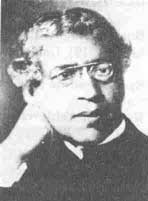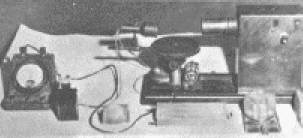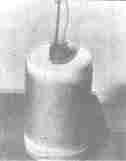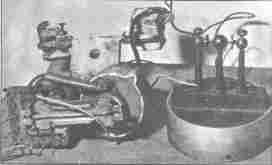The blog is mainly a general knowledge page for all age groups who are interested in improving their knowledge. I have tried to make the explanations as simple as I can. I have made use of tht for gathering the facts.
Popular Posts
-
HIPPOCRATES Father of Medicine in the Western World. As we saw from the postings on Sushruta and Charakan, medicne and surgery was quite ...
-
DEAR ALL, SWAMI VIVEKANANDA JAYANTHI, JANUARY 12 2011 Swami Vivekananda was born in Calcutta (Now Kolkata) Monday in a traditional family...
-
Sangam Age in Tamil Kingdoms The history of the Tamil country becomes clear only from the Sangam period. The word Sangam means an assoc...
-
Ernest Rutherford Discovers the Structure of an Atom. 1911 Ernest Rutherford in academic garb. Courtesy Edgar Fahs Smith Mem...
-
The Rani of Jhansi Regiment was the Women's Regiment of the Indian National Army, the armed force formed by Indian nationalists in 1942 ...
-
Arikamedu Pondicherry This is a historic site which has revealed ancient Roman artifacts that are evidence of the thriving trade that exist...
-
Serendip...WHAT? T he Kingdom of Serendip Once upon a time there was an oriental and exotic Kingdom called Serendip, the memory of whic...
-
History of Medicine The historic contribution of Sushruta ,(600-500BC) circa the ancient surgeon of India, is well recognised for his i...
-
Brihdeshwar Temple has been declared as world heritage site in 1987 AD. The temple is located in the rice bowl district of Tamil Nadu, Than...
-
FATHERS OF SURGERY AND MEDICINE 4200 BC -- CAPT AJIT VADAKAYIL FATHER OF SURGERY -- ACHARYA SUSHRUTA FATHER OF MEDICINE -- ACHARYA CHA...
Popular Posts
-
HIPPOCRATES Father of Medicine in the Western World. As we saw from the postings on Sushruta and Charakan, medicne and surgery was quite ...
-
DEAR ALL, SWAMI VIVEKANANDA JAYANTHI, JANUARY 12 2011 Swami Vivekananda was born in Calcutta (Now Kolkata) Monday in a traditional family...
-
Sangam Age in Tamil Kingdoms The history of the Tamil country becomes clear only from the Sangam period. The word Sangam means an assoc...
-
Ernest Rutherford Discovers the Structure of an Atom. 1911 Ernest Rutherford in academic garb. Courtesy Edgar Fahs Smith Mem...
-
The Rani of Jhansi Regiment was the Women's Regiment of the Indian National Army, the armed force formed by Indian nationalists in 1942 ...
-
Arikamedu Pondicherry This is a historic site which has revealed ancient Roman artifacts that are evidence of the thriving trade that exist...
-
Serendip...WHAT? T he Kingdom of Serendip Once upon a time there was an oriental and exotic Kingdom called Serendip, the memory of whic...
-
History of Medicine The historic contribution of Sushruta ,(600-500BC) circa the ancient surgeon of India, is well recognised for his i...
-
Brihdeshwar Temple has been declared as world heritage site in 1987 AD. The temple is located in the rice bowl district of Tamil Nadu, Than...
-
FATHERS OF SURGERY AND MEDICINE 4200 BC -- CAPT AJIT VADAKAYIL FATHER OF SURGERY -- ACHARYA SUSHRUTA FATHER OF MEDICINE -- ACHARYA CHA...
Pages
Total Pageviews
Wednesday, August 31, 2011
Apgar scoring in the newborn
This Week | Inventor Archive | Inventor Search
Inventor of the Week Archive
Browse for a different Invention or Inventor
Newborn Scoring System
Virginia Apgar was a trailblazer: one of Columbia University's first female M.D.s (1933), and one of the first American women to specialize in surgery. Frustrated by chauvinism during her internship, Apgar changed her focus to anesthesiology, which became a specific and separate medical discipline thanks to her. In 1949, she became Columbia's first-ever full Professor of Anesthesiology.
Apgar's research on anesthesia and childbirth led her to her greatest innovation: the Newborn Scoring System---better known as the "Apgar Score"---for assessing the health of newborn infants, which she conceived in 1949, refined, and finally published in 1953. Up until that time, babies at birth were assumed to be in good health unless they exhibited some obvious difficulty or defect: needless to say, internal deficiencies (e.g., circulatory or respiratory) could be missed, resulting all too often in death. Because Apgar realized that "Birth is the most hazardous time of life," she created a system for quickly and accurately assessing a baby's health in the crucial minutes after birth.
Apgar's system assigns a maximum score of 2 points each for 5 criteria: respiratory effort, reflex irritability, muscle tone, heart rate, and color. The assessment is made at one and five minutes after birth (at fifteen minutes for babies born by cesarean section). A perfect score of 10 and 10 is rare in practice; but a score of at least 7 and 7 virtually guarantees a newborn's health. A lower score alerts obstetricians to the possibility of latent problems (e.g., hemorrhaging, asphyxia), which can then, if necessary, be detected and treated on the spot. Apgar's diagnostic regimen has saved countless lives, and has long been a standard worldwide. The compliment of one famous physician holds true: "Every baby born in a modern hospital anywhere in the world is looked at first through the eyes of Virginia Apgar."
In 1959, Apgar was appointed Director of the March of Dimes. In that capacity, she continued her energetic efforts to improve the healthcare of infants and children. By the time of her death in 1974, Virginia Apgar was admired for her great contributions to society as well as to science.
[May 1997]
This Week | Inventor Archive | Inventor Search
Inventor of the Week Archive
Browse for a different Invention or Inventor
Newborn Scoring System
Virginia Apgar was a trailblazer: one of Columbia University's first female M.D.s (1933), and one of the first American women to specialize in surgery. Frustrated by chauvinism during her internship, Apgar changed her focus to anesthesiology, which became a specific and separate medical discipline thanks to her. In 1949, she became Columbia's first-ever full Professor of Anesthesiology.
Apgar's research on anesthesia and childbirth led her to her greatest innovation: the Newborn Scoring System---better known as the "Apgar Score"---for assessing the health of newborn infants, which she conceived in 1949, refined, and finally published in 1953. Up until that time, babies at birth were assumed to be in good health unless they exhibited some obvious difficulty or defect: needless to say, internal deficiencies (e.g., circulatory or respiratory) could be missed, resulting all too often in death. Because Apgar realized that "Birth is the most hazardous time of life," she created a system for quickly and accurately assessing a baby's health in the crucial minutes after birth.
Apgar's system assigns a maximum score of 2 points each for 5 criteria: respiratory effort, reflex irritability, muscle tone, heart rate, and color. The assessment is made at one and five minutes after birth (at fifteen minutes for babies born by cesarean section). A perfect score of 10 and 10 is rare in practice; but a score of at least 7 and 7 virtually guarantees a newborn's health. A lower score alerts obstetricians to the possibility of latent problems (e.g., hemorrhaging, asphyxia), which can then, if necessary, be detected and treated on the spot. Apgar's diagnostic regimen has saved countless lives, and has long been a standard worldwide. The compliment of one famous physician holds true: "Every baby born in a modern hospital anywhere in the world is looked at first through the eyes of Virginia Apgar."
In 1959, Apgar was appointed Director of the March of Dimes. In that capacity, she continued her energetic efforts to improve the healthcare of infants and children. By the time of her death in 1974, Virginia Apgar was admired for her great contributions to society as an honarary member
Tuesday, August 30, 2011
Monday, August 29, 2011
Indian Inventions and Discoveries...Cotton gin, single-roller
For the first two thousand years after people started to grow cotton in India, they just picked the seeds out by hand before they began tospin the cotton into thread. About 500 BC, cotton growers in India invented a machine with gears to turn rollers to get the seeds out of the cotton more quickly and easily.

Indian cotton gin machine.
Over time, people improved this machine, so that it could be run first by foot pedals and then by water power, using the current of a fast stream to turn the rollers.
Eli Whitney's cotton gin
When white people first began to grow cotton in North America in the 1600's AD, they brought over the cotton churka from India to help them get the seeds out. In the 1700's AD, people in the southern part of North America began to grow more and morecotton. Along the Atlantic coast, they could grow long-staple cotton, with long fibers that would work in the Indian cotton churka. But when people began to grow cotton further from the ocean, they found that the long-staple cotton didn't grow well there. They found a new short-staple kind of cotton, and grew that. But the old churkas wouldn't take the seeds out of this new short-staple cotton.
Cotton farmers forced African people to work as slaves and pick the cotton seeds out by hand. Mostly they made them do it in the evenings, after they'd already worked all day in the fields picking the cotton. This was too slow, and it made cotton very expensive - so expensive that nobody wanted to make clothes out of it.
This was a big problem, and a lot of people began to work on inventing a new kind of churka that would get the seeds out of short-staple cotton. Finally in 1793, just after the Revolutionary War, a young white man named Eli Whitney did invent a cotton gin that worked. It was a lot like the old churka, but it had steel teeth that caught the cotton fibers, and a system of pulleys to pull harder.
Eli Whitney
Cotton farmers all used the new cotton gin, and cotton clothing got so cheap that many people began to wear cotton instead of linen. Clothes got a lot cheaper, so that for the first time in history most people had more than one outfit to wear. The bad part was that in order to plant and pick so much cotton, the cotton farmers brought over thousands and thousands more African people to be their slavesand work in the cotton fields. Most of the African people who came to North America as slaves came because of the cotton gin.
Sunday, August 28, 2011
Coherer, iron and mercury:he Bengali physicist Jagdish Chandra Bose. ..FATHER OF RADIO.
J.C. BOSE: CAN WE CALL HIM THE FATHER OF RADIO?
 | Jagdish Chandra Bose (1858-1937) Born 30 November 1858 (Mymensingh, Bangladesh) Died 23 November 1937; D.Sc. (1896), University of London, UK Specialization: Optics, Electromagnetic Radiation, Plant Physiology |
Sir J.C. Bose did his original scientific work in the area of Microwaves. He made his own equipment by employing an illiterate tin-smith whom he trained up to do the job for him. He produced extremely short waves and done considerable improvement upon Hertz's detector of electric waves. He produced a compact appratus for generating electromagnetic waves of wavelengths 25 to 5 mm and studying their quasioptical properties, such as refraction, polarization and double refraction. These could be demonstrated by his compact apparatus mounted on an ordinary spectrometer table. The most satisfactory polarizers and analyzers were made out of pressed jute fibres or books with laminated pages. He could even produce rotation of plane of polarization by transmission of electric rays through bundle of twisted jute fibres. The originality and simplicity of his apparatus were its remarkable features. Bose's research on response in living and non-living led to some significant findings: in some animal tissues like muscles, stimulation produces change in form as well as electrical excitation, while in other tissues (nerves or retina), stimulation by light produces electric changes only but no change of form. He showed that not only animal but vegetable tissues under different kinds of stimuli-mechanical, application of heat, electric shock, chemicals, drugs- produce similar electric responses.
 The Microwave receiver developed by Bose
The Microwave receiver developed by Bose
The receiver which was made by Bose represented a great advance compared to that of even Hertz. He was said to be the first to employ a semi-conductor like galena as a self recovering detector of electric rays.

The Galena detector developed by Bose
Bose could successfully produce a flash of radiation by pressing a key; the waves were only about half an inch in length; while the receiver was so sensitive that it responded to the feeblest electric reaction. In the year 1895, at the Presidency College, Calcutta, Bose demonstrated the possibility of signalling by ether waves, message to a distance. In the Calcutta Town Hall also, before a large gathering, he transmitted waves through the body of the chairman of the meeting, the Lieutant Governor of Bengal, and then through a solid wall, displacing a heavy weight, a mine placed in closed room.

The Microwave transmitter developed by Bose
Nearly 100 years after Guglielmo Marconi's first transatlantic wireless communication, a group of scientists of the US-based Institute of Electronics and Electrical Engineers (IEEE) reported that -"the origin and first major use of the solid state diode detector devices led to the discovery that the first transatlantic wireless signal in Marconi's world famous experiment was received by Marconi using the iron-mercury-iron coherer with a telephone detector invented by Sir J.C.Bose in 1898".
Bose's invention of the "mercury coherer with a telephone" which Marconi used was published in the Proceedings of the Royal Society, London, on April 27, 1899, over two years before Marconi's first wireless communication on December 12, 1901, from NewFoundland, now in Canada.
Investigations by the IEE group show that both Bose and Marconi were in London in 1896-97. The Italian was conducting wireless experiments for the British post office and Bose was on a lecture tour. Both the scientists were interviewed by McClure's Magazine (now defunct) in March 1897.
In the interview, Bose came out with high praise for Marconi, then under attack from established British scientists who doubted his credentials. Marconi never could make it to college because of his poor high school record. Bose also said he was not interested in commercial telegraphy and that others could use his research work.
In 1899, Bose unveiled his invention of the mercury coherer with the telephone detector in a paper at the Royal Society.
Brilliant Marconi quickly grasped the commercial importance of Bose's invention and began to explore it secretly. His childhood friend Luigi Solari started experimentally with Bose's invention and presented Marconi with a slightly modified design in the summer of 1901 for use in the upcoming transatlantic experiment.The Chronology:
1895
J.C. Bose ignites gunpoder and rings a bell at a distance using electromagnetic waves, proving for the first time in history communication signals can be sent without using wires.
1896
Bose is in London on a lecture tour and so is Marconi, who is conducting wireless experiments for the British post office. In an interview, Bose also says he is not interested in commercial telegraphy and others can use his research work.
1899
Bose announces the invention of the "iron-mercury-iron coherer with telephone detector" in a paper presented at Royal Society, London.
Sources:
" Discovery of Millimeter Waves by Sir J.C. Bose" by Prof. P.K. Ray, Director, Bose Institute, Calcutta : Hamfest India'96 Souvenir
" Bose invented Marconi's wireless"- by Mita Mukherjee : The Telegraph, Calcutta, Saturday 1 November, 1997.
"Fellows of the Indian National Science Academy" Vol.1 (Diamond Jubilee Compendium),1994, Indian National Sci
 The Microwave receiver developed by Bose
The Microwave receiver developed by BoseThe receiver which was made by Bose represented a great advance compared to that of even Hertz. He was said to be the first to employ a semi-conductor like galena as a self recovering detector of electric rays.

The Galena detector developed by Bose
Bose could successfully produce a flash of radiation by pressing a key; the waves were only about half an inch in length; while the receiver was so sensitive that it responded to the feeblest electric reaction. In the year 1895, at the Presidency College, Calcutta, Bose demonstrated the possibility of signalling by ether waves, message to a distance. In the Calcutta Town Hall also, before a large gathering, he transmitted waves through the body of the chairman of the meeting, the Lieutant Governor of Bengal, and then through a solid wall, displacing a heavy weight, a mine placed in closed room.

The Microwave transmitter developed by Bose
Nearly 100 years after Guglielmo Marconi's first transatlantic wireless communication, a group of scientists of the US-based Institute of Electronics and Electrical Engineers (IEEE) reported that -"the origin and first major use of the solid state diode detector devices led to the discovery that the first transatlantic wireless signal in Marconi's world famous experiment was received by Marconi using the iron-mercury-iron coherer with a telephone detector invented by Sir J.C.Bose in 1898".
Bose's invention of the "mercury coherer with a telephone" which Marconi used was published in the Proceedings of the Royal Society, London, on April 27, 1899, over two years before Marconi's first wireless communication on December 12, 1901, from NewFoundland, now in Canada.
Investigations by the IEE group show that both Bose and Marconi were in London in 1896-97. The Italian was conducting wireless experiments for the British post office and Bose was on a lecture tour. Both the scientists were interviewed by McClure's Magazine (now defunct) in March 1897.
In the interview, Bose came out with high praise for Marconi, then under attack from established British scientists who doubted his credentials. Marconi never could make it to college because of his poor high school record. Bose also said he was not interested in commercial telegraphy and that others could use his research work.
In 1899, Bose unveiled his invention of the mercury coherer with the telephone detector in a paper at the Royal Society.
Brilliant Marconi quickly grasped the commercial importance of Bose's invention and began to explore it secretly. His childhood friend Luigi Solari started experimentally with Bose's invention and presented Marconi with a slightly modified design in the summer of 1901 for use in the upcoming transatlantic experiment.The Chronology:
1895
J.C. Bose ignites gunpoder and rings a bell at a distance using electromagnetic waves, proving for the first time in history communication signals can be sent without using wires.
1896
Bose is in London on a lecture tour and so is Marconi, who is conducting wireless experiments for the British post office. In an interview, Bose also says he is not interested in commercial telegraphy and others can use his research work.
1899
Bose announces the invention of the "iron-mercury-iron coherer with telephone detector" in a paper presented at Royal Society, London.
Sources:
" Discovery of Millimeter Waves by Sir J.C. Bose" by Prof. P.K. Ray, Director, Bose Institute, Calcutta : Hamfest India'96 Souvenir
" Bose invented Marconi's wireless"- by Mita Mukherjee : The Telegraph, Calcutta, Saturday 1 November, 1997.
"Fellows of the Indian National Science Academy" Vol.1 (Diamond Jubilee Compendium),1994, Indian National Sci
Saturday, August 27, 2011
200–400: Stepwell in India

View of a stepwell at Fatehpur, Shekhawati. This one featured in the movie Paheli.

Chand Baori, in the village of Abhaneri near Bandikui, Rajasthan.
Stepwells, also called bawdi (Hindi: बावड़ी) or baoli (Hindi: बावली), or vaav (Gujarati: વાવ) are wells or ponds in which the water can be reached by descending a set of steps. They may be covered and protected, and are often of architectural significance. It can be multi-storied also in which a bullock turns the water wheel ("Rehat") to raise the water in the well to the first or second floor.
They are most common in the west of India. They may be also found in the other more arid regions of the subcontinent, extending into Pakistan. The construction may be utilitarian, but sometimes includes significant architectural embellishments.
A number of distinct names, sometimes local, exist for stepwells. In Hindi speaking regions, they include names based on baudi (including bawdi, bawri, baoli, bavadi, bavdi). In Gujarati and Marwari language, they are usually called vav or vaav.
All forms of the stepwell may be considered to be particular examples of the many types of storage and irrigation tanks that were developed in India, mainly to cope with seasonal fluctuations in water availability. A basic difference between stepwells on the one hand, and tanks and wells on the other, was to make it easier for people to reach the ground water, and to maintain and manage the well.
Stepwell construction is known to have gone on from at least 600 AD. Most existing stepwells date from the last 800 years. There are suggestions that they may have originated much earlier, and there are some suggestions that precursors to them can be seen in the Indus Valley civilisation.the giant step well of abhaneri in rajasthan state in india
Friday, August 26, 2011
Indian Inventions...Calico
 |
| A piece of calico used in a shopping bag |
Calico is a plain-woven textile made from unbleached, and often not fully processed, cotton. It may contain unseparated husk parts, for example. The fabric is less coarse and thick than canvas or denim, but owing to its unfinished and undyed appearance, it is still very cheap. Originally from the city of Kozhikode,Kerala, India (known by Europeans as Calicut in the 11th century). The fabric was made by the traditional weavers called chaliyans. The raw fabric was dyed and printed in bright hues and calico prints became popular in Europe.
Calico originated in Kozhikode, India (also known as Calicut) during the 11th century. It was mentioned in Indian literature by the 12th century when the writer Hemacandra described calico fabric prints with a lotus design. By the 15th century calico from Gujarat made its appearance in Egypt. Trade with Europe followed from the 17th century onwards. Calico was woven using Surat cotton for both the warp and weft.
TERMINOLOGY:
In the US:
- Calico—cotton fabric with a small, all-over floral print [8]
- Muslin—simple, cheap equal weft and warp plain weave fabric in white, cream or unbleached cotton and/or a very fine, light plain weave cotton fabric (sometimes called muslin gauze).
- Muslin gauze—the very lightest, most open weave of muslin.
- Gauze—any very light fabric, generally with a plain weave
- Cheesecloth—extremely soft and fine cotton fabric with a very open plain weave.
In the UK, Australia and New Zealand:
- Calico—simple, cheap equal weft and warp plain weave fabric in white, cream or unbleached cotton.
- Muslin—a very fine, light plain weave cotton fabric.
- Muslin gauze—muslin.
- Gauze—extremely soft and fine cotton fabric with a very open plain weave.
- Cheesecloth—gauze.
Subscribe to:
Posts (Atom)


